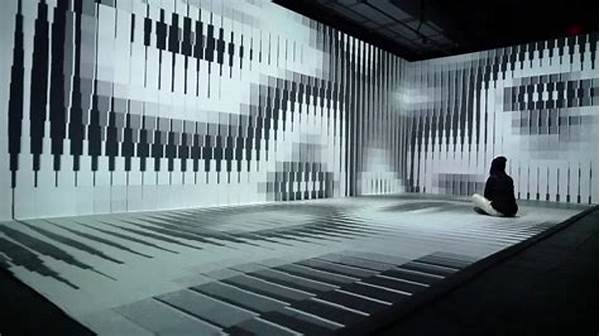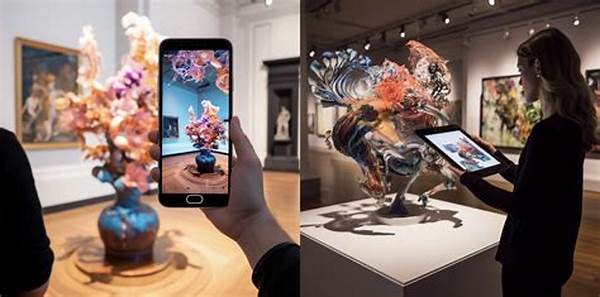The Rise of Sound-Responsive Art Installations
Sound-responsive art installations are a fascinating fusion of technology and creativity, where auditory senses interact with visual experiences. These installations are transforming how we experience art by making it an immersive and interactive encounter. Artists utilize sound sensors and advanced software to create an environment where the art reacts to ambient sounds, music, or even the viewer’s voice. In recent years, such installations have gained momentum in galleries and public spaces, captivating audiences worldwide with their dynamic and engaging nature.
Read Now : Artist Portfolio Dynamic Compositions
Consider a gallery where as you speak or clap, the ambient visuals transform in harmony with the generated sound. This interaction not only enhances the experience but also encourages visitors to become active participants in the art itself. The sheer unpredictability of sound-responsive art installations ensures that no two experiences are ever the same. Moreover, they offer a unique platform for artists to explore new dimensions of creativity and challenge traditional forms of art expression.
The appeal of sound-responsive art installations lies in their ability to engage multiple senses simultaneously. The auditory and visual elements work together to create a multisensory experience that often leaves a lasting impression on the audience. By incorporating advanced technologies, artists are reimagining the role of sound in art, fostering a deeper connection between the viewer and the artwork.
Technology Behind Sound-Responsive Art Installations
1. Sound Sensors: Sound-responsive art installations rely on sophisticated sound sensors to detect auditory inputs. These sensors capture vibrations and variations in sound, which are then translated to visual outputs in real-time.
2. Interactive Software: Advanced software drives the interaction within sound-responsive art installations. It processes sound data and creates corresponding visual effects, ensuring a seamless and engaging experience for visitors.
3. Artistic Algorithms: Artists design specific algorithms that determine how sound influences visual transformations. These algorithms ensure that each interaction is unique, adding an element of surprise and dynamism to the installation.
4. Dynamic Display Systems: These installations often incorporate cutting-edge display technology—such as LED screens or projection mapping—to effectively manifest the visual aspects that respond to sound inputs.
5. Multi-sensory Integration: Beyond just sight and sound, some installations include tactile components, allowing for a fully immersive sensory experience that broadens the potential of sound-responsive installations.
The Cultural Impact of Sound-Responsive Art Installations
In the contemporary art world, sound-responsive art installations represent a significant shift in the interaction between art and audience. These installations transcend the boundaries of traditional art by inviting audience participation and fostering a collaborative atmosphere. Visitors are no longer passive observers but active contributors to the art-making process. This approach democratizes art, making it more accessible and engaging for a diverse audience.
Furthermore, sound-responsive art installations are being increasingly recognized for their educational potential. Museums and educational institutions are leveraging these innovative installations to teach concepts ranging from sound waves to interactive design. The participatory element of these installations enhances learning experiences, making complex concepts more approachable and comprehensible. This democratization of art and education emphasizes the role of technology in bridging gaps in understanding and appreciation among diverse audiences.
The rise of sound-responsive art installations also underscores the evolving relationship between technology and creativity. Artists are increasingly exploring how technology can enhance artistic expression, leading to new and innovative art forms. As technology continues to evolve, the potential for sound-responsive art installations will only expand, creating new opportunities for artistic exploration and audience engagement. This synergy of technology and art holds endless possibilities for shaping the future of creative expression.
Creating Engaging Sound-Responsive Art Installations
1. Concept Development: A strong conceptual foundation is crucial for impactful sound-responsive art installations. Artists must carefully plan how sound and visuals will interact to create a cohesive and immersive experience.
2. Site-Specific Designs: Successful installations often consider their environment, tailoring the interaction to complement the unique acoustics and spatial characteristics of the site.
3. Audience Engagement: Sound-responsive art installations should be designed with audience participation in mind. Engaging the audience promotes interaction and allows for a more personal experience with the artwork.
4. Collaborative Efforts: Artists may collaborate with technologists, sound engineers, and other professionals to enhance the installation’s effectiveness and ensure seamless integration of various components.
Read Now : Networking Tips For Artists With Galleries
5. Continuous Innovation: Embracing new technologies and methodologies ensures that sound-responsive art installations remain fresh, captivating, and relevant in the ever-changing landscape of the art world.
6. Feedback and Iteration: Gathering audience feedback allows artists to refine their installations, ensuring they remain engaging and responsive to the needs and expectations of participants.
7. Narrative and Emotion: Effective installations often incorporate a narrative or emotional component, enriching the audience’s experience and connection to the piece.
8. Cultural Relevance: Tailoring installations to reflect current cultural themes or societal issues can increase their impact and resonance with audiences.
9. Technical Excellence: Ensuring high-quality technical execution, from audio capture to visual display, is vital for the success of a sound-responsive installation.
10. Sustainability: Considering the environmental impact and employing sustainable materials and technologies can enhance the ethical appeal of the installation.
Exploring the Future of Sound-Responsive Art Installations
Sound-responsive art installations are an exciting frontier in contemporary art, where technology and creativity converge to create interactive experiences. As technology advances, so too will the capabilities of these installations, potentially incorporating elements like artificial intelligence to further enhance the interaction between sound and art. Imagine an installation that not only reacts to sound but also learns and adapts based on audience interactions, forging a deeper connection between the artwork and its participants.
Looking ahead, sound-responsive art installations could become more accessible, breaking free from the confines of galleries to occupy public spaces and everyday environments. This democratization of interactive art could make creative expression an integral part of daily life, offering unique and personalized experiences to a broader audience. Such accessibility could inspire individuals who might not otherwise engage with art to explore and appreciate innovative forms of expression.
Furthermore, the collaboration between artists, technologists, and audiences in developing sound-responsive art installations could result in more culturally relevant and impactful artworks. By leveraging the power of sound, these installations can spark dialogue and reflection on societal issues, fostering a deeper understanding and appreciation among diverse communities. As we continue to explore the potential of sound-responsive art installations, their role in shaping cultural landscapes and influencing how we perceive art and technology will undoubtedly expand.
The Impact of Sound-Responsive Art Installations
In the landscape of modern art, sound-responsive art installations stand out due to their ability to forge deeper connections and interactions between artwork and audience. These installations transform passive viewers into active participants, inviting them to engage with the art in a more personal and meaningful way. By responding to sounds, these installations create a unique dialogue with the audience, empowering them to shape the visual narrative through their auditory contributions.
Educational institutions and public galleries have embraced sound-responsive art installations for their ability to simplify complex concepts and foster interactive learning environments. By enabling participants to observe real-time transformations, these installations demystify abstract ideas, making them more approachable and understandable. This pedagogical value extends beyond traditional art appreciation, encouraging audiences to explore the intersection of art, technology, and science.
Moreover, sound-responsive art installations continue to impact artistic practice and development. By bridging the gap between static art forms and dynamic, responsive experiences, artists are rethinking how they create and present their work. These installations provide an opportunity to experiment with innovative techniques and ideas, challenging conventional boundaries and redefining the art landscape. As sound-responsive art installations evolve, they will continually enrich the cultural fabric, offering new ways to experience and interact with art.



